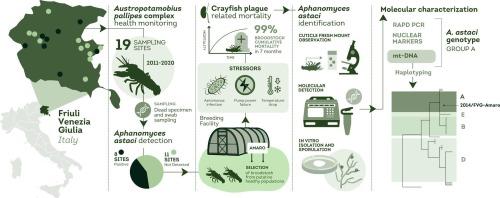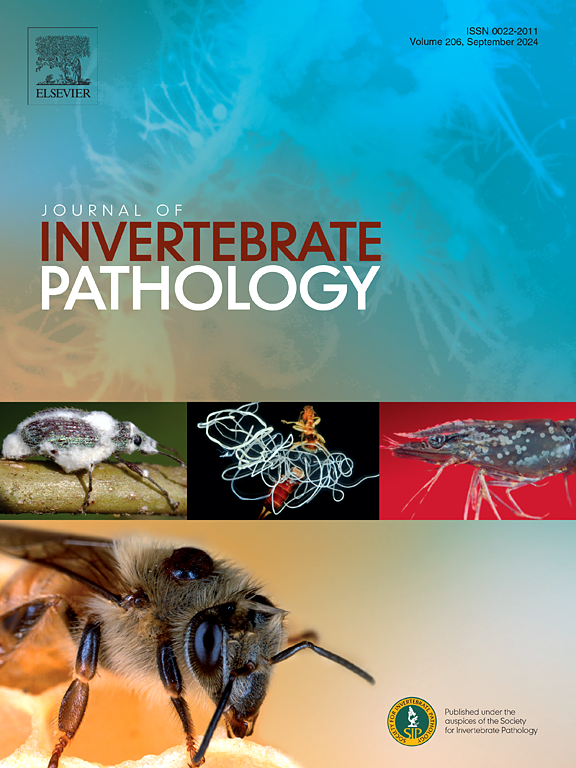Chronic Aphanomyces astaci infection in wild white-clawed crayfish: risks and implications for breeding programs
IF 2.4
3区 生物学
Q1 ZOOLOGY
引用次数: 0
Abstract
Aphanomyces astaci is the oomycete responsible for crayfish plague, a disease with devastating effects on susceptible crayfish populations across Eurasia. Recently, low virulence strains of this oomycete, mostly belonging to genetic group A, have been reported to coexist with European crayfish species. Between 2011 and 2020, 19 populations of white-clawed crayfish, Austropotamobius pallipes complex, were monitored in North-eastern Italy to detect the presence of A. astaci using molecular assays. Chronic infection was documented in eight populations, two of which were found to be persistently thriving despite A. astaci infection, remaining positive for the pathogen for at least two years. For conservation purposes, broodstock were collected from wild populations of A. pallipes where A. astaci had not been detected and housed in a breeding facility. However, a few months after the last introduction of broodstock into the facility, a crayfish plague outbreak ensued, leading to an extended mortality period of seven months. The A. astaci strain responsible for the outbreak, identified as genotype and haplotype group A, was isolated and characterised by three independent molecular methods: RAPD-PCR, mtDNA and genotype-specific nuclear markers. Epidemiological evaluations suggested that the pathogen was introduced into the facility via broodstock carrying an undetected chronic infection. The observed mortality was probably triggered by a combination of biotic and abiotic stressors. These findings highlight the importance of an appropriate health monitoring of the broodstock collected for ex situ breeding purposes and are notably relevant to the conservation of the European crayfish species.

野生白爪小龙虾的慢性阿斯塔隐菌感染:风险和对育种计划的影响。
小龙虾鼠疫是一种对欧亚大陆易感小龙虾种群具有破坏性影响的疾病。最近,这种卵菌的低毒力菌株,主要属于遗传群A,已被报道与欧洲小龙虾物种共存。2011年至2020年,在意大利东北部对19个白爪小龙虾种群(Austropotamobius pallipes complex)进行了监测,利用分子分析方法检测了阿斯塔西螯虾的存在。在8个种群中记录了慢性感染,其中2个种群尽管感染了阿斯塔奇单胞虫,但仍持续生长,至少在两年内病原体呈阳性。出于保护目的,从未发现白斑拟南芥的野生种群中收集亲鱼,并将其安置在繁殖设施中。然而,在最后一次将母鱼引入该设施几个月后,小龙虾瘟疫爆发,导致死亡期延长至7个月。导致此次暴发的阿斯达伊螨菌株被鉴定为基因型和单倍型A组,并通过三种独立的分子方法进行了分离和表征:RAPD-PCR、mtDNA和基因型特异性核标记。流行病学评估表明,该病原体是通过携带未被发现的慢性感染的亲鱼传入该设施的。观察到的死亡率可能是由生物和非生物压力因素共同引发的。这些发现强调了对为迁地繁殖目的收集的亲鱼进行适当健康监测的重要性,并与欧洲小龙虾物种的保护特别相关。
本文章由计算机程序翻译,如有差异,请以英文原文为准。
求助全文
约1分钟内获得全文
求助全文
来源期刊
CiteScore
6.10
自引率
5.90%
发文量
94
审稿时长
1 months
期刊介绍:
The Journal of Invertebrate Pathology presents original research articles and notes on the induction and pathogenesis of diseases of invertebrates, including the suppression of diseases in beneficial species, and the use of diseases in controlling undesirable species. In addition, the journal publishes the results of physiological, morphological, genetic, immunological and ecological studies as related to the etiologic agents of diseases of invertebrates.
The Journal of Invertebrate Pathology is the adopted journal of the Society for Invertebrate Pathology, and is available to SIP members at a special reduced price.

 求助内容:
求助内容: 应助结果提醒方式:
应助结果提醒方式:


